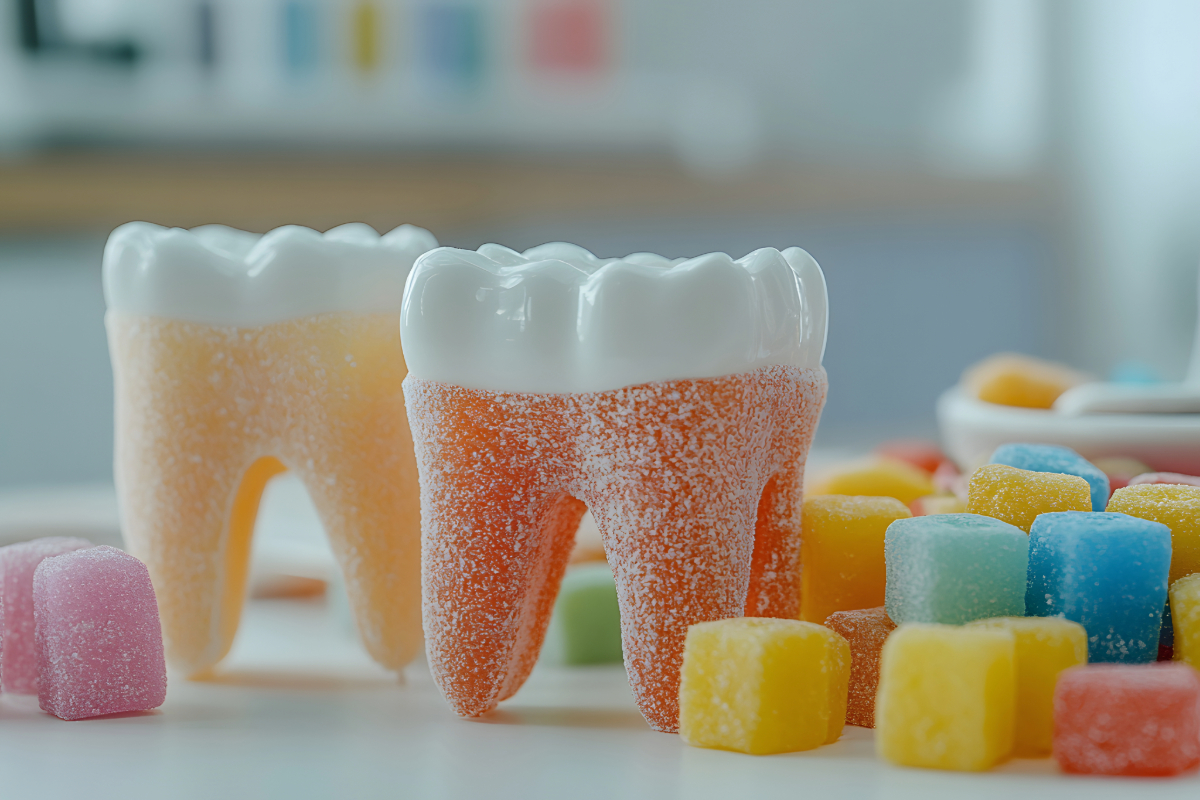
How Sugar Affects Your Child’s Teeth and How to Cut Back
As parents, we all want our children to have bright, healthy smiles that will last a lifetime. However, one of the biggest culprits of dental issues, particularly cavities, is something that most kids absolutely love: sugar. Whether it’s in candy, sodas, or even seemingly innocent snacks, sugar can significantly impact your child’s dental health. Understanding how sugar affects your child’s teeth and how to cut back on sugary foods and drinks can help promote long-term oral health.
The Link Between Sugar and Cavities
When children consume sugary foods and drinks, the bacteria in their mouths feed on the sugar, creating acids as a byproduct. These acids attack the enamel, the hard outer layer of the teeth, leading to decay. Over time, the enamel can break down, creating holes, or cavities, in the teeth.
Here’s a Simple Breakdown of How it Works:
- Sugar consumption: When your child eats or drinks sugar, the sugar doesn’t immediately disappear. It interacts with the bacteria in their mouth.
- Acid production: The bacteria turn the sugar into acid.
- Acid attacks: The acid then begins to erode the tooth enamel, causing decay.
- Cavity formation: If the acid attacks are not neutralized or managed, cavities can form, leading to toothaches, infections, and even the need for fillings or other dental treatments.
It’s important to note that sugar doesn’t just cause problems after large amounts of candy or soda. Even smaller, seemingly harmless snacks like fruit juices or granola bars can be high in sugar and contribute to enamel erosion. Additionally, the frequency of sugar consumption is a significant factor in how much damage is done. The more often sugar is consumed, the more opportunities the bacteria have to produce acids, and the higher the risk of developing cavities.
Why Are Children More Vulnerable to Sugar’s Effects?
Children’s teeth are more susceptible to cavities than adult teeth for several reasons:
- Thinner enamel: A child’s enamel is thinner and softer, making it more prone to erosion.
- Dietary habits: Children often snack throughout the day, which means their teeth are exposed to sugar and acids more frequently.
- Inconsistent brushing: Younger children may not brush their teeth thoroughly or often enough, which makes it harder to remove sugar and bacteria.
- Juices and sports drinks: Many kids enjoy sugary drinks, which often sit in their mouths longer than solid food. This provides more time for bacteria to feed on the sugars and produce acid.
All these factors combined make it essential for parents to stay vigilant about their child’s sugar intake and overall oral hygiene.
The Consequences of Too Much Sugar
The effects of too much sugar on your child’s teeth are not just cosmetic. Cavities and decay can lead to pain, infections, and potentially costly treatments. Here are some of the potential consequences:
- Cavities: Untreated cavities can grow larger, affecting the tooth’s structure and function.
- Tooth sensitivity: As cavities form and enamel erodes, teeth may become sensitive to hot and cold foods.
- Infections: Severe decay can cause infections, which might require root canals or tooth extractions.
- Speech and chewing difficulties: Decayed teeth can affect your child’s ability to chew or speak properly, leading to developmental concerns.
- Low self-esteem: Dental problems can affect a child’s self-esteem and confidence, particularly if they are embarrassed by their smile.
How to Cut Back on Sugar for Better Oral Health
Fortunately, reducing sugar intake doesn’t have to be a battle. Here are some practical strategies for cutting back on sugar to protect your child’s teeth while still keeping them happy and satisfied.
1. Limit Sugary Drinks
One of the biggest culprits in a child’s diet is sugary beverages, including soda, fruit juices, and sports drinks. These drinks are not only high in sugar but also stay in the mouth longer, giving bacteria more time to attack the teeth. Encourage your child to drink water or milk instead. If they do enjoy juice, try diluting it with water to cut down on sugar content.
2. Choose Healthy Snacks
Instead of reaching for sugary snacks, offer alternatives like:
-
- Fresh fruits (such as apples, berries, or bananas)
- Vegetables (carrot sticks, cucumber slices)
- Cheese sticks or yogurt (without added sugars)
- Whole-grain crackers or nuts
These options not only promote better dental health but also offer important nutrients to support your child’s overall well-being.
3. Read Labels
Many packaged foods contain hidden sugars. Be sure to check the ingredient labels when buying snacks or drinks for your child. Look for items with minimal added sugars and avoid products with long lists of sugary ingredients. Words like “corn syrup,” “high fructose corn syrup,” and “honey” are all forms of sugar.
4. Set a Routine for Brushing
Proper oral hygiene is key to preventing cavities. Make sure your child brushes their teeth at least twice a day with fluoride toothpaste. For younger children, brushing can be a fun activity, and you can help make it enjoyable by letting them choose a colorful toothbrush or a toothpaste flavor they like.
5. Offer Sugar-Free Gum
If your child has a sweet tooth and needs a treat, sugar-free gum can be a good alternative. Chewing gum stimulates saliva production, which helps neutralize acids and wash away food particles. Look for gums containing xylitol, which can help reduce cavity-causing bacteria in the mouth.
6. Make Healthy Sweet Treats at Home
You don’t have to eliminate sweets entirely, but try making healthier homemade alternatives. For example, you can bake treats using less sugar or swap sugar for natural sweeteners like applesauce or mashed bananas. This way, you can still satisfy your child’s sweet tooth while keeping their teeth safe.
7. Regular Dental Checkups
Regular dental visits are essential for keeping your child’s teeth healthy. At Wabash Valley Children’s Dentistry, we can monitor your child’s oral health, provide fluoride treatments, and give advice on proper brushing techniques. If cavities are caught early, treatment is typically less invasive and less expensive.
Conclusion
Sugar is one of the most significant contributors to dental problems, particularly cavities, in children. By understanding how sugar affects your child’s teeth and adopting strategies to reduce sugar intake, you can help protect your child’s smile for years to come. Focus on healthy snack choices, limit sugary drinks, and maintain a solid oral hygiene routine to give your child the best chance for a cavity-free future.
If you have concerns about your child’s dental health or want more personalized advice on managing sugar in their diet, don’t hesitate to contact Wabash Valley Children’s Dentistry. Together, we can work to ensure that your child’s teeth stay healthy, strong, and beautiful!
